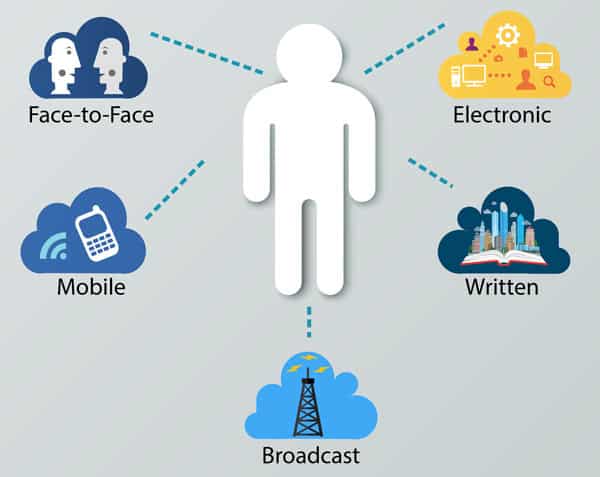What Is A Communication Channel?
The method you use to distribute your message is called a communication channel. Some communication channels include e-mail, letters, brochures, television advertising and social media posts. Each channel has its own unique set of characteristics that must be considered, including cost to produce and distribute, speed of delivery, and the efficiency and effectiveness of reaching the intended audience. Depending on your communication objectives, one channel may be more effective than others.
Choosing the Right Communication Channel
In today’s globalized world, businesses need to communicate with their audience in different regions and countries to succeed. Effective communication is crucial for organizations to achieve their business objectives and build strong relationships with clients, partners, and stakeholders worldwide. However, with so many communication channels available, it can be challenging to choose the right one to reach your target audience.
In this article, we will provide insights and guidelines on how to choose the most effective communication channels for your business. We will discuss the factors to consider when selecting communication channels, such as your target audience, communication strategy, business objectives, and cultural differences. We will also examine different communication channels, including traditional and digital media, written and oral communication, and formal and informal channels.
How To Choose The Most Effective Communication Channel
Choosing the most effective communication for your communication goal can be challenging. Even in routine interactions, you need to decide if it is better to communicate face-to-face, by e-mail, phone call or text message. When communicating with foreign-speaking audiences and culturally diverse audiences, you must determine which channel offers the greatest likelihood for success. If you are an international marketer, identifying the right channel can be very difficult. If you are a General Counsel for an internationally operating consumer products company, you may have to determine how to communicate recall announcements. In some cases, you may not be able to afford television advertising. Furthermore, the same channels may not be available in all countries and in all languages.
As old communication channels decline or fail, new communication channels evolve and flourish. Consequently, as businesses have become more knowledgeable about using a mixture of communication strategies, they have moved advertising money from print and broadcast channels to Internet advertising, such as Google Adwords, Facebook and Twitter, to promote their products and services. Businesses currently give perks to bloggers to talk about their products and also hire strong social influencers to write positive opinions. Online activity generated from social media and advertising can be analyzed to learn more about the people interested in products and services to develop more highly targeted campaigns.
As traditional communication channels continue to decline in popularity, many newspapers and publishers are developing online presences. Cable television and streaming services like Netflix, Prime and Hulu have caused similar viewership declines for the 4 big broadcast networks. Advertising options have become limitless, however, with ads appearing on grocery receipts, the sides of busses and buildings, and in hotel rooms and public restrooms.
Factors To Consider When Selecting Communication Channels
When choosing communication channels, it’s essential to consider several factors, such as:
Target audience: The communication channels you choose should resonate with your target audience. For example, if you are targeting millennials, social media platforms like Instagram and Snapchat may be more effective than traditional channels like television and print media.
Communication strategy: Your communication strategy should align with your overall business strategy. For instance, if your business objective is to increase brand awareness, advertising on billboards, and social media may be more effective than direct mail or email marketing.
Business objectives: Different communication channels may be more effective for achieving specific business objectives. For example, if your objective is to generate leads, trade shows, and events may be more effective than social media.
Cultural differences: Cultural differences can play a significant role in selecting communication channels. For example, in some cultures, in-person communication may be more effective than written communication, while in others, email may be more appropriate.
Communication Channels to Reach Global Markets
There are various communication channels businesses can use to reach their global audience, such as:
Traditional Media: Traditional media channels include print media, television, radio, and outdoor advertising. Traditional media is still prevalent in many countries, especially in developing countries. However, traditional media can be expensive, and the reach and effectiveness may vary based on the country and language.
Digital Media: Digital media channels include social media, search engine marketing, and display advertising. Digital media is rapidly growing and can be highly targeted and cost-effective. However, digital media requires a different skill set and may not be as effective in some countries where internet penetration is low.
Written Communication: Written communication channels include direct mail, email marketing, and brochures. Written communication can be highly targeted, personalized, and cost-effective. However, written communication may not be appropriate for urgent or time-sensitive messages.
Oral Communication: Oral communication channels include phone calls, video conferencing, and in-person meetings. Oral communication is effective for building relationships and resolving complex issues. However, oral communication may not be appropriate for specific messages that need to be referenceable.
Informal Communication: Informal communication channels include instant messaging, Slack, and social media. Informal communication can be highly engaging, immediate, and accessible. However, informal communication may not be appropriate for confidential or formal messages.
Choosing Communication Channels: A Guide
To help businesses choose the right communication channels, we have developed a guide that outlines the factors to consider when selecting communication channels based on the type of message.
Urgent Messages: For urgent messages, oral communication channels like voice and video calls or in-person meetings may be more appropriate. Urgent messages should be delivered as soon as possible, and oral communication channels allow for immediate feedback and clarification.
Time-Sensitive Messages: For time-sensitive messages, written communication channels like direct emails or text messages may be more appropriate. Written communication channels allow for messages to be delivered quickly and efficiently without the need for real-time communication.
Confidential Messages: For confidential messages, formal communication channels like written communication through secure email or direct mail may be more appropriate. Formal communication channels provide a level of security and confidentiality that informal channels may not provide.
Specific Messages: For specific messages, communication channels should be chosen based on the message’s content and the target audience’s preferences. For example, a message that requires a detailed explanation may be better communicated through written channels like email, while a message that requires emotional persuasion may be better communicated through oral channels like phone calls.
Group Communication: For group communication, digital media channels like video conferencing and social media may be more appropriate. Digital media channels provide the ability to reach a large audience simultaneously and allow for collaboration and engagement.
One-on-One Communication: For one-on-one communication, oral communication channels like voice and video calls or in-person meetings may be more appropriate. One-on-one communication provides a personalized approach and allows for a more in-depth discussion.
Company-wide Communication: For company-wide communication, written communication channels like email or internal messaging platforms like Slack may be more appropriate. Written communication channels allow for consistent messaging and can be easily referenceable.
Communicating In Foreign Languages
When communicating to a foreign audience, businesses must analyze the many communication channels available and determine which ones would be most advantageous, given their communication objectives and budgetary restrictions. One of the first questions to ask is whether it makes sense to use a written communication channel or a verbal communication channel. A company like 24 Hour Translation can help you decide. The benefits of each are listed below.
Use written messages to:
• Communicate challenging facts and figures that take time to study and digest
• Escape the risk of unintended reactions and feelings
• Schedule dates and times and modify plans
• Direct attention to significant points
• Resolve business and legal matters
Use Oral messages to:
• Persuade others using emotion
• Resolve conflicts among large groups
• Get instantaneous feedback
Conclusion: Channel Surfing for a People-Centered Workplace
Choosing the right communication channels is critical for businesses to reach their target audience and achieve their business objectives. Businesses should consider factors like their target audience, communication strategy, business objectives, cultural differences, and the type of message when selecting communication channels. Businesses should also evaluate their communication channels periodically to ensure that they are still effective and relevant.
In addition to choosing the right communication channels, businesses should also focus on creating a people-centered workplace that values trust, teamwork, and effective communication. Businesses should provide the necessary tools, resources, and insights to help their employees communicate effectively and efficiently.
Finally, businesses should also leverage events and client success stories to showcase their expertise and insights in international communications. By sharing their experiences and successes, businesses can build trust and credibility with their target audience and position themselves as experts in their industry.
In summary, choosing the right communication channels is essential for businesses to reach their global audience and achieve their business objectives. By focusing on creating a people-centered workplace, providing the necessary tools and resources, and showcasing their expertise through events and client success stories, businesses can build strong relationships with their target audience and position themselves for resilience and success.



